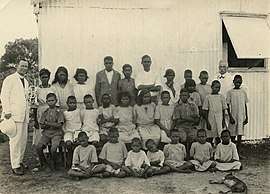Kahlin Compound
Kahlin Compound was an institution for part-Aboriginal people in Darwin in the Northern Territory of Australia between 1913 and 1939. After 1924, "half-caste" children were separated from the adults and moved to an institution at Myilly Point.
| Kahlin Compound Darwin, Northern Territory | |||||||||||||||
|---|---|---|---|---|---|---|---|---|---|---|---|---|---|---|---|
 Children at the Kahlin Compound in 1921 | |||||||||||||||
 Kahlin Compound | |||||||||||||||
| Coordinates | 12°27′10″S 130°49′43″E | ||||||||||||||
| LGA(s) | City of Darwin | ||||||||||||||
| |||||||||||||||
History
In 1913 the Northern Territory Protector of Aborigines, anthropologist Walter Baldwin Spencer decided to solve what he called the "half-caste problem" by rounding up hundreds of Aboriginal children and removing them from the "native camp"'. The Kahlin Compound and Half Caste Home was established on Lambell Terrace at Myilly Point, overlooking Mindil Beach in Darwin.[1] Spencer envisaged that the compound would be self-sufficient, providing housing, schooling and domestic training for each Aboriginal family. The whole compound was to be fenced with access for Aboriginals and Departmental officials only.[2]
A 1923 Commonwealth parliamentary inquiry headed by the South Australian Senator John Newland included an investigation of conditions at the Compound. Newland recommended that it be moved to a site further from the town, but this did not happen (perhaps because the residents were a source of cheap labour).[3]
A subsequent inquiry appointed by the NT Administrator also recommended the establishment of a new compound be established and also that "half-caste" children should be separated from adults, in a separate institution where they could be disciplined and integrated into the [white] community. The new "Half-Caste Home" was opened at Myilly Point in 1924, and most of the Kahlin children were moved there.[3]
The compound was damaged in the 1937 cyclone.[4]
All residents were moved to the new Bagot Aboriginal Reserve in 1938. The Kahlin Compound closed in 1939 and was revoked as an Aboriginal Reserve on 3 July 1940.[3]
The site was used as an emergency hospital during a meningitis outbreak in 1940.[5]
Current use
.jpg)
The site of the Kahlin Compound remains a vacant block. An attempt made in 2003 to have the site listed on the Northern Territory Heritage Register as recognition of its cultural history was unsuccessful.[6]
See also
- Stolen generations
References
- "'The soul of Darwin': the story of the Kahlin Compound". Australian Broadcasting Corporation. Earshot, Radio National. 7 July 2015. Retrieved 27 September 2016.
- "Kahlin Compound: Background Historical Information". NT Heritage Register. Northern Territory Government. Retrieved 1 October 2016.
- "Kahlin Compound (1913 - 1939)". Find and Connect. Australian Government. Retrieved 2 October 2016.
- "Cyclone at Darwin leaves trail of unroofed and ruined houses and lays waste surrounding country". The Sydney Morning Herald (30, 951). 16 March 1937. p. 14. Retrieved 1 October 2016 – via National Library of Australia.
- "Epidemic dread in Darwin". The Sun (9658). Sydney. 17 December 1940. p. 3 (Late Final Extra). Retrieved 1 October 2016 – via National Library of Australia.
- "Kahlin Compound". NT Heritage Register. Northern Territory Government. Retrieved 1 October 2016.